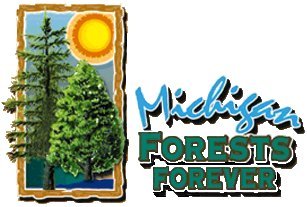

Home Page |
MICHIGAN FORESTS FOREVER TEACHERS GUIDE
| TIMBER SALE CONTRACTS |
|
A contract is a key document that clarifies the understanding between the forestowner and the logging contractor. Neither party benefits from initiating a timber sale without fully knowing the expectations of each other. The fewer surprises that come up, the better. Forestowners should not be pressured into signing a contract or be blinded by the high value of good timber. Many times, forestowners don't fully appreciate the true monetary value of their resource. Timber should be treated the same as any other high value asset. Hiring a professional forester to work as a forestowner agent is highly recommended.
There are two broad categories of payment, lump sum and sale-by-scale. Lump sum is a single price for the whole sale. A scale sale is where different prices are paid for different species and products (logs, pulpwood, poles, bolts, etc.). The "scale" (volume measurement) can be done by a forester, at a wood-using mill, or by other arrangement.
A lump sum sale is easiest to administer and easier when it comes to income tax time. However, it is less accurate than a scale sale. Often times, a lump sum payment is best for timber sales where the products come mostly from a single tree species and product. For example, a red pine thinning will consist mostly of red pine pulpwood. The same is true of an aspen clearcut, although some price adjustment would need to be made if a significant quantity of aspen bolts were present.
Where there are a variety of tree species and products, such as in some northern hardwood stands, a scale sale will better reflect what gets harvested. The logger will pay for precisely what is harvested and the forestowner will get paid for the same. For example, much of a northern hardwood sale will consist of hardwood pulpwood, but there is often a mix of sawlogs and, perhaps, some high quality veneer. The veneer prices may bring several hundred dollars per 1000 board feet, depending upon the tree species. The hardwood pulpwood may run $20-30 per cord, or more. Setting a price for each species and product may provide the best equity for all parties involved.
SOME of the items to consider in a timber sale contract (not intended to be a complete list of all possible contingencies). Each sale is unique and should be reviewed by a professional forester to minimize the risk to forest owners and logging contractors. Click here for a sample timber sale contract. .
| Item | Explanation |
| Names & Addresses of seller and
buyer Location of timber (legal description, etc.) Proof/guarantee of ownership by seller Stumpage prices Down payment specification Bond requirement Payment schedule Seller ownership until payment in full Date of sale closure Seasons/conditions when logging is prohibited Workman's Compensation & Insurance Contractor qualifications Termination clause Schedule for cutting of unmarked trees Treatment of slash Source of arbitration for disputes Specify access Specify skid trail and landing layout Specify scaler and scale method Stump height specifications Road, ground, and landing condition Explanation of timber markings Use of forest owner facilities Litter clause |
Allows each party to check references
on each other. Reduces chances for timber trespass. Mostly a protection for the logger! Prices per unit volume negotiated BEFORE signing. Usually 10-20 percent of estimated total sale value. $500 to 10% of sale value, sort of like a deposit against damage. Larger sales should have payments built in before completion date. Maintains control of cut products by seller until payment is done. A definite ending date helps protect seller. Can be re-negotiated. Winter-only sale, wet periods, hunting seasons, etc. Assurance of compliance with state law and liability issues. Consider SFE* certification and MPLC* membership. Protects seller from non-compliance by buyer. Agreed upon penalties for certain unanticipated or improper cutting. Often important for visual and wildlife habitat reasons. A third party, maybe the consulting forester. Should be understood by seller, buyer, or adjacent owners. Mutual understanding between seller and buyer. Agreement in advance for scale sales. Mutual understanding, may be important in deep snow country. Clear understanding of ruts, holes, etc. during logging operations. Make sure buyer knows the sellers intent. Understanding for use of buildings, fields, bridges, etc. Refuse left on-site, oil changes, etc. |
| Contract Suggestions Solicit advice from an attorney, especially for high value sales. Make sure all understandings are in writing. Oral agreements mean little in light of written agreements. Make sure everyone understands everything in the contract. Make sure you ask questions! Avoid mistakes in the contract. Check over several times. Use language understood by everyone. Avoid "legalese". Most contract clauses are enforceable only when the buyer is at fault. Loggers aren't responsible for events outside their control. Seller must divulge any special considerations BEFORE negotiating a contract. Do not sign a contract just to get the sale going. Understand everything first and take the time to think about it. All parties involved should have a copy of the contract. * SFE = Sustainable Forestry Education. Sample contracts are available from MSU Extension offices and other sources. The MSU Extension publication number is E-1656 (from November, 1995). |
|
| Activity Suggestions PLT The Value of 100 Acres of Forest Land |
 |
This website was developed and created by Michigan State University Extension for the teachers of the State of Michigan. |